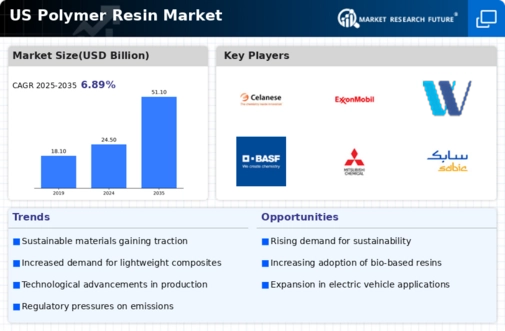The US Polymer Resin Market is characterized by a high level of competition, driven by innovation, technological advancements, and shifting consumer demands. This market encompasses a diverse range of polymer resins, including thermoplastics, thermosets, and elastomers, each catering to various industries such as automotive, packaging, and construction. As companies vie for market share, competitive insights such as pricing strategies, product differentiation, and supply chain management become increasingly crucial. The presence of both established players and emerging startups adds to the dynamics, as some organizations leverage their extensive experience while others bring fresh ideas and agility to the market.
Furthermore, sustainability has become a key focus, with companies increasingly looking to develop eco-friendly materials and processes to meet regulatory requirements and customer preferences. In the context of the US Polymer Resin Market, Celanese stands out with its strong market presence and extensive portfolio of engineered materials. The company is recognized for its capabilities in providing innovative solutions tailored to customer needs, which positions it favorably against competitors. Celanese's strengths lie in its commitment to research and development, enabling the company to introduce new polymer formulations that improve performance characteristics such as durability, heat resistance, and environmental impact.
This focus on innovation ensures that Celanese remains relevant and competitive within the market landscape. Additionally, the company's robust manufacturing capabilities and strategic partnerships enhance its supply chain efficiency, allowing for quick responsiveness to market changes and customer demands.On the other hand, ExxonMobil is a formidable player within the US Polymer Resin Market, known predominantly for its extensive portfolio of advanced polymer products and resins. The company manufactures a wide array of solutions that cater to numerous applications, underscoring its versatility and technical expertise.
ExxonMobil's strengths are amplified by its position as a leading energy producer, allowing it to maintain competitive pricing structures and supply stability. The company is actively engaged in mergers and acquisitions that bolster its market presence and expand its product offerings, further solidifying its role in the polymer resin segment. ExxonMobil's focus on innovation is evident in its efforts to develop high-performance polymers and sustainable solutions aimed at reducing environmental impact, contributing to the advancement of polymer technology in the US market.
With a well-established distribution network and comprehensive service capabilities, ExxonMobil continues to be a significant force within the competitive landscape of the US Polymer Resin Market.























Leave a Comment